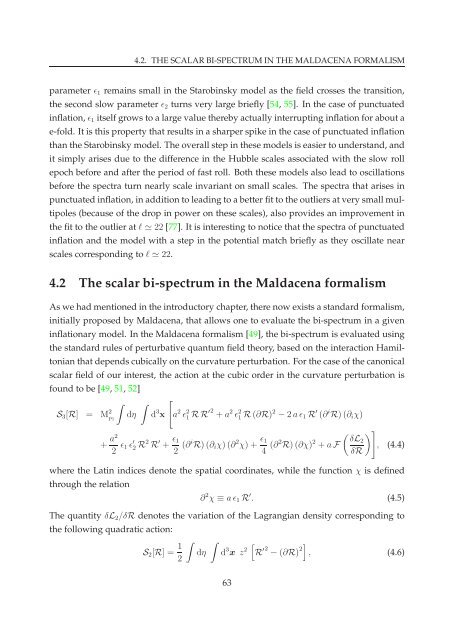PHYS08200605006 D.K. Hazra - Homi Bhabha National Institute
PHYS08200605006 D.K. Hazra - Homi Bhabha National Institute
PHYS08200605006 D.K. Hazra - Homi Bhabha National Institute
You also want an ePaper? Increase the reach of your titles
YUMPU automatically turns print PDFs into web optimized ePapers that Google loves.
4.2. THE SCALAR BI-SPECTRUM IN THE MALDACENA FORMALISM<br />
parameter ǫ 1 remains small in the Starobinsky model as the field crosses the transition,<br />
the second slow parameter ǫ 2 turns very large briefly [54, 55]. In the case of punctuated<br />
inflation,ǫ 1 itself grows to a large value thereby actually interrupting inflation for about a<br />
e-fold. It is this property that results in a sharper spike in the case of punctuated inflation<br />
than the Starobinsky model. The overall step in these models is easier to understand, and<br />
it simply arises due to the difference in the Hubble scales associated with the slow roll<br />
epoch before and after the period of fast roll. Both these models also lead to oscillations<br />
before the spectra turn nearly scale invariant on small scales. The spectra that arises in<br />
punctuated inflation, in addition to leading to a better fit to the outliers at very small multipoles<br />
(because of the drop in power on these scales), also provides an improvement in<br />
the fit to the outlier atl ≃ 22 [77]. It is interesting to notice that the spectra of punctuated<br />
inflation and the model with a step in the potential match briefly as they oscillate near<br />
scales corresponding to l ≃ 22.<br />
4.2 The scalar bi-spectrum in the Maldacena formalism<br />
As we had mentioned in the introductory chapter, there now exists a standard formalism,<br />
initially proposed by Maldacena, that allows one to evaluate the bi-spectrum in a given<br />
inflationary model. In the Maldacena formalism [49], the bi-spectrum is evaluated using<br />
the standard rules of perturbative quantum field theory, based on the interaction Hamiltonian<br />
that depends cubically on the curvature perturbation. For the case of the canonical<br />
scalar field of our interest, the action at the cubic order in the curvature perturbation is<br />
found to be [49, 51, 52]<br />
∫ ∫ [<br />
S 3 [R] = M 2 dη d 3 x a 2 ǫ 2 Pl<br />
1 RR′2 +a 2 ǫ 2 1 R(∂R)2 −2aǫ 1 R ′ (∂ i R)(∂ i χ)<br />
+ a2<br />
2 ǫ 1ǫ ′ 2 R2 R ′ + ǫ 1<br />
2 (∂i R)(∂ i χ)(∂ 2 χ)+ ǫ 1<br />
4 (∂2 R)(∂χ) 2 +aF<br />
( ) ] δL2<br />
, (4.4)<br />
δR<br />
where the Latin indices denote the spatial coordinates, while the function χ is defined<br />
through the relation<br />
∂ 2 χ ≡ aǫ 1 R ′ . (4.5)<br />
The quantity δL 2 /δR denotes the variation of the Lagrangian density corresponding to<br />
the following quadratic action:<br />
S 2 [R] = 1 2<br />
∫<br />
dη<br />
∫<br />
d 3 x z 2 [R ′2 −(∂R) 2] , (4.6)<br />
63
















